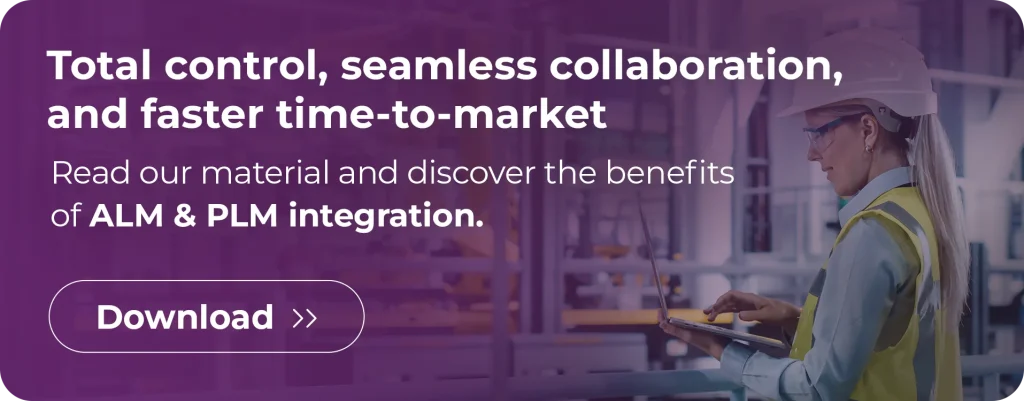Test Automation with ALM Solutions – enhancing the quality of digital products

Modern IT systems are becoming increasingly complex, while software delivery cycles are getting shorter. In this environment, traditional manual testing is no longer sufficient. The key to ensuring high quality? Automated application testing integrated with Application Lifecycle Management (ALM).
What does ALM offer?
ALM is a set of processes, automation tools, and practices that help manage every stage of software development – from requirements management, design, coding, and testing (including all testing activities like functional tests, API tests, optimization, and retesting) to deployment and maintenance. Typical ALM features include:
- Requirements management
- Test planning and execution
- Defect tracking
- Version and change management
- Integration with CI/CD tools and code repositories
Thanks to ALM, you can track changes in real time and maintain information continuity at every stage of the project – a critical capability in regulated industries like automotive, aerospace, and healthcare.
The role of test automation in ALM
Software test automation is a key extension of ALM functionality. It links automated tests with requirements and code changes. The difference between manual and automated tests, is that unlike manual tests, automated tests can be rerun with each system update, ensuring consistent results and fast regression validation. This enables early defect detection, better quality management, and quality assurance at every stage of the product lifecycle.
Types of automated tests
Different types of automated tests serve various purposes, including:
- Unit tests
- Integration tests
- API tests
- Functional tests
Each test type evaluates a different layer of software behavior and supports effective requirements management and quality control throughout the application lifecycle.
Test automation process
The test automation process includes selecting tools, analyzing and designing test cases, preparing test scripts, and executing automated tests. Clear goal-setting and success criteria are essential prior to implementation. Test cases should be linked to business requirements to ensure full traceability and compliance with industry standards.
Test automation pyramid
The Test Automation Pyramid is a concept that helps prioritize test types in a project. At the base are unit tests, followed by integration tests, with system and acceptance tests at the top. This approach optimizes costs and supports efficient lifecycle management.
Test and test case management
Effective test and test case management enables rapid response to project changes and thorough documentation of the testing process. Application lifecycle management systems like PTC Codebeamer support lifecycle management, making it easier to track test results and manage defects.
Technical benefits of automation in ALM
- Regression testing – automatically run test suites with each change
- Traceability – directly link tests to requirements and defects
- Compliance & auditability – full test history and results logging, compliance reporting
- Team collaboration – a single source of truth for DEV, QA, and Compliance teams

Codebeamer – an ALM tool supporting test automation
PTC Codebeamer ALM is an enterprise-grade solution that enables:
- Modeling and structuring of requirements
- Defining and automating test cases
- Linking tests to requirements, risks, and defects
- Integration with CI/CD and test frameworks (e.g., Jenkins, Selenium, GitLab)
- Generating compliance reports and traceability documentation for audits
Example – ISO 26262: In Codebeamer, safety requirements can be mapped to tests, unit/API/functional tests can be triggered automatically, results linked to software versions, and complete audit documentation generated.
How does it work? – technical architecture
A typical test automation setup using PTC Codebeamer includes:
- Application Lifecycle Management system
- Automated testing tools (e.g., Selenium WebDriver, Robot Framework, Telerik Test Studio)
- CI/CD systems
- Code repositories
Each new code commit triggers an automated test process via the CI pipeline. Test results are fed back into the ALM system and linked to specific requirements – providing a complete, traceable flow from requirement to test execution and result. This is critical for compliance and auditing.
Benefits – impact on quality and compliance
Using automation tools within ALM solutions allows you to:
- Detect regressions faster (regression and integration testing)
- Reduce production bugs
- Better meet quality requirements (e.g., safety, reliability)
- Ensure comprehensive test process documentation – crucial for audits and certifications
Challenges and best practices in ALM test automation implementation
Even with advanced tools like Codebeamer, implementing test automation within ALM environments involves organizational and technical challenges:
- Data migration – transferring requirements, test cases, and defect histories from other systems
- Integration – with existing systems and tools
- User adoption – ensuring team buy-in and usage
- Customization – tailoring the platform to company-specific processes
One key challenge is data migration. Using dedicated migration tools and detailed planning can help minimize the risk of information loss.
Another major factor is user adoption. Without proper user engagement, even the best tools won’t deliver results. Comprehensive training, access to a well-structured knowledge base and up-to-date documentation, and involving users early in the implementation process all help align the platform with team needs. In the case of Codebeamer, maintaining a centralized knowledge base is especially important, as it supports consistent usage practices and accelerates onboarding for new team members.
Integration with existing infrastructure is also critical. Although Codebeamer supports broad integrations, every organization is unique. Custom APIs or dedicated connectors may be needed, requiring experienced technical staff.
Finally, it’s important to recognize that test automation and ALM implementation is an ongoing process. Continuous improvement, regular reviews, and updates are essential to adapt to changing business and technical requirements.
How to implement a system like Codebeamer
- Clearly define project goals and expected outcomes
- Involve key stakeholders early
- Provide training and support for end users
- Regularly monitor implementation effectiveness and collect feedback
- Implement automation in stages, starting with critical processes
- Prioritize security, regulatory compliance, and auditability
Case Study: Implementing PTC Codebeamer at Impact Clean Power Technology S.A.
A successful example of Codebeamer implementation is a project carried out by TT PSC for Impact Clean Power Technology S.A., a leader in energy storage solutions.
The goal was to digitize and centralize software lifecycle management – from requirements definition and test automation to documentation and compliance traceability.
Implementing PTC Codebeamer significantly reduced test preparation and execution time, ensured full transparency, and simplified audit and regulatory compliance. Centralized information and process automation allowed for quicker responses to changes and better project risk management.
This project demonstrated that Codebeamer performs well both in highly regulated environments and in organizations requiring flexibility and speed.
Learn more here: Implementation of Codebeamer to streamline software lifecycle management
Conclusions
An integrated approach to test automation in ALM environments is now one of the most effective quality assurance methods in software projects. Solutions like Codebeamer provide comprehensive requirements and test management along with full compliance with international standards.
For organizations, this means:
- Reduced testing time and costs
- Higher quality final products
- Improved collaboration across engineering teams
A key advantage is the support for scalable processes. Scalability – one of Codebeamer’s flagship value – means that the platform’s capabilities grow proportionally with the progress of project work and the size of the organization. This ensures that the tool remains effective and efficient regardless of whether it’s supporting a single team or an enterprise-level rollout. At the same time, Codebeamer’s adaptability allows it to fit seamlessly into the organization’s existing technical, procedural, and situational environment.

